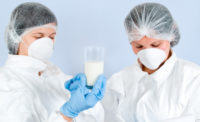Food safety is at the core of every successful food business. When making a purchasing decision on food, consumers have to trust that the food manufacturers
| Jump to: |
have delivered a product that is safe to consume. Your brand name is the contract between you and your customer on the safety and quality of your products and the future of your business.
As the food industry continues to strive for product excellence, here are several best practices for addressing compliance regulations and enhancing your traceability and recall programs.
1. Food Safety Modernization Act
Consumer concerns regarding food safety led to the United States Congress passing the 2011 FDA Food Safety Modernization Act (FSMA), resulting in the biggest change to food safety regulation in over 100 years. Through the FSMA, FDA inspectors now have access to food manufacturers' safety records. The FDA has already proposed new regulations required for the implementation of FSMA, and some parts of the Act are already in place.
Facility registration is required of food facilities that process and hold food or ingredients. This does not include food store or foodservice facilities, as these are regulated by state and local agencies. If you have not already registered your facility with the FDA, it is imperative that you do so. This has been a requirement since 2003, but FSMA added a new required filing with the FDA in 2012.
Best Practices
Double check to ensure your firm is registered with the FDA as required by FSMA. FDA has increased its number of inspections of food manufacturers, and as a result, the number of disciplinary actions taken by the Department of Justice has increased as well. These actions include shutting down operations, which then requires that the manufacturer meet several legal standards before the facility can return to operation. Additionally, there has also been an increase in the number of charges brought against company officers and management of food firms when serious regulatory compliance issues have been identified.
Best Practices
Ensure that you have a plan in place to take corrective actions if a food safety issue is identified.
Review your protocols for handling regulatory inspections. Do the procedures reflect the requirements of FSMA?
2. Product Recalls
There were over 2,300 FDA-regulated food products recalled in 2012, and recalls are continuing at a record pace. Most of the food recalls in 2012 were due to microbiological contamination, and a high percentage of contaminations were in refrigerated and frozen products. The facility environment can sometimes be a source of contamination.
Best Practices
Review and monitor the environment to protect your product from post-process contamination.
While over 99% of the food product recalls are done voluntarily by food companies, FSMA gives the FDA authority to mandate a product recall when a firm is unwilling to cooperate in removing contaminated products from the marketplace. FSMA also requires that a firm have a written recall plan that outlines who in the company is authorized to recall products and who has the responsibility to oversee the recall.
Best Practices
If faced with a recall, keep in mind the requirements of the FDA Reportable Food Registry. Review your product recall program to make sure it is up to date. In your recall plan, be sure to include references to third-party services that may be required during a recall to fulfill regulatory requirements of an effective recall.
3. Traceability
In recent years, a majority of food recalls involved more than a single production lot. In fact, several recalls pertained to all products produced over an extended period of time, in some cases upwards of two years. These are economic disasters for the recalling firm. The amount of product that is necessary to be recalled can be controlled with good processing records and lot coding practices. If deviations exist in these records, it will increase the size of the product recall. Every food firm should have a written protocol on the definition of a production lot or product.
Best Practices
Traceability must start with the receipt of raw ingredients and packaging materials at the receiving dock.
Production records must capture the lot code information from raw material usage and document the amount of use in the production of the final product.
Lot code identification on final products must be traceable to a production date and identify the plant where produced. It is also helpful if the packages include a production line and timestamp. And, the lot code must be readable.
Best Practices
The Bioterrorism Act of 2002 requires the food industry to keep records of receipts and shipments of food, food ingredients and packaging one step back and one step forward. There are multiple ways that this can be achieved to fulfill these regulatory requirements. The purpose of these requirements is to provide a means to trace contaminated ingredients or products in either direction to facilitate epidemiological investigations. Such traceability is very important to food companies as a means to limit their liabilities to either exonerate or control the firm’s legal exposure during a recall. Companies can often use invoices, packing slips or bills of lading to provide this traceability. Other companies maintain computerized documents outlining their quality assurance and shipping records, allowing for automated detailed record keeping.
Best Practices
Conduct an audit of your quality control records for accuracy and readability.
Conduct mock traceability exercises on various products that you produce. Mock traceability exercises should be timed and evaluate the accuracy of recouping the full volume of the designated product.
Cross-train multiple layers of plant staff in handling traceability exercises.
4. Product Recall Preparedness
Each year, more than 1,000 food companies in North America are faced with conducting a food recall. Each recall is as unique as the people at your company. While there are some core elements that must be followed during a recall, there are many twists and turns in the journey to an effective recall.
The first step is to take prompt action when a product contamination becomes known. Next, it is critical to identify all lots of contaminated product in a single recall announcement so as to eliminate confusion with consignees and consumers.
There are many different recall communication pieces that must be issued to effectively communicate a recall. A recall is not complete until verification has been made to ensure all consignees have received the communication and have taken action as directed in the recall notice.
Additionally, the effectiveness of the recall must be evaluated. All of the recall communications must be documented alongside a summary that outlines the results of a root cause analysis.
Best Practices
Review the company recall plan and procedures to ensure they are up-to-date and reflect current regulatory requirements.
Conduct a mock recall within the company to make sure that you are prepared to react and can handle a major recall.
The planning that goes into the recall process as well as the ability to promptly trace your products and ingredients are all very important in protecting the safety of consumers, your brand and the financial assets of your company.




